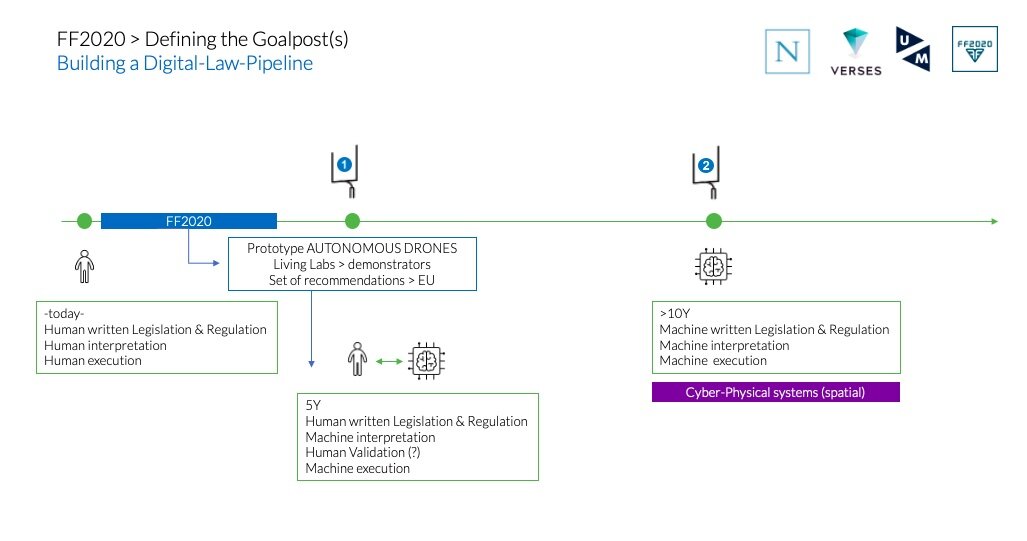Can machines understand human laws?
Self-driving cars. Hospital robots. Drones that deliver parcels. Seven years ago, a blogpost on this topic would have had all the makings of a dystopian fiction. A futuristic dream or a script for a compelling sci-fi movie. These days, robotics are gradually becoming part of our lives. Articles examine their potential, robots are already roaming our streets and they will be commonplace as breathing in a few decades.
Whether you love them or hate them, there is at least one issue that we cannot afford to ignore: legislation. A robot needs to know how to perform its duties lawfully and ethically. Self-driving cars must know the highway code and be able to apply it. The same applies to drones, which are also subject to privacy laws. You may think that this legislation can be easily coded into a machine. But it’s not that simple, as we know from experience with Nalantis and Flying Forward 2020.
© Adobe Stock
Autonomous machines and human laws: three layers of complexity
We identified three complexities that are obstacles on our path. The first complexity is that regulations are still drafted by people for people. Given that machines are unable to read or understand them, this is not very useful to them.
Globalisation is the second complexity. As an industrial robotics manufacturer, you can easily scale up internationally but this requires you to take various layers of legislation into account: international, European, provincial, regional, municipal... in the many different languages that are spoken around the world. Try navigating that as a human ... You can see how difficult it would be to get a robot to comply with all these laws. You’d need vast amounts of manpower to manually code all this into a machine.
The third and final complexity is the quantifiability of legislation. Or the lack thereof. European regulations state, for example, that operators must fly ‘safely’. But safety means different things to different people. My idea of safe may be borderline in your eyes. If we humans are unable to reach a conclusive opinion on specific laws, then why should we expect robots to do this?
“If we humans are unable to reach a conclusive opinion on specific laws, then why should we expect robots to do this?”
From human-to-human to machine-to-machine
Then again, I would not be writing a blogpost about this issue if there was no solution at hand. Because that is what we like to do at Nalantis: solve complex matters with our next-gen technology. Which is why we didn’t hesitate for a moment when we were asked to join Flying Forward 2020. This consortium wants to promote Urban Air Mobility (the transport of goods and passengers by drones) in Europe by developing a safe, effective and socially acceptable infrastructure.
The project gathers partners from different sectors, each with their own expertise, objectives and duties. Some instances focus on how to make Urban Air Mobility socially acceptable. What if docking stations for drone couriers suddenly pop up on our streets? What if people lose their jobs to robots? These are just some of the issues they study. And rightfully so, because they should not be overlooked in this ground-breaking evolution.
At Nalantis, we have joined forces with the University of Maastricht and Verses, among others, to develop a roadmap for legislation. There are three major milestones:
Human-to-human legislation, or the current state of affairs. A human operator must interpret and understand legislative texts that were drafted by humans.
In our wildest dreams, this means transitioning to a human-to-machine environment in the next five years. Meaning that autonomous drones can understand legislation drafted by humans.
At some point in the future (that is difficult to pinpoint), we may even achieve machine-to-machine legislation, i.e., regulations that are drafted, understood, interpreted and implemented by machines.
Converting language into meaning
These three complexities are the major challenges that our consortium has identified. Milestones that we want to achieve, step by step, all in good time. Our first task? To make recommendations on how legislators can draft legislation in such a way that it is easier to understand for machines. This puts us on track to achieve the first objective, i.e., the human-to-machine milestone.
You may wonder why this is Nalantis’ job? Because this relates to machines that need to understand language in a semantic context. Our language technology can transpose (legislative) texts into meaning, so that machines can read, understand and interpret them. This know-how makes us the ideal partner – along with other organisations within Flying Forward 2021 - to tackle these challenges head-on and contribute to the future of Urban Air Mobility.
To answer the question: can machines understand human laws? Not yet. But ask me again in five years.
Read more about Nalantis’s role in the Flying Forward 2020 project in this interview.





